Flowering Magnolia Trees Are A Truly Beautiful Sight – Here’s How To Grow Yours

TREES > MAGNOLIA

Elizabeth is a Permaculture Garden Designer, Sustainability Consultant and Professional Writer, working as an advocate for positive change. She graduated from the University of St. Andrews with an MA in English and Philosophy and obtained a Diploma in Applied Permaculture Design from the Permaculture Association.
Reviewed By DAN ORI

Dan has over 27 years’ under his belt caring for plants and gardens. Working as a Horticultural Instructor and Consultant, he draws on a diverse range of experience that includes working as a Head Gardener, Tree Surgeon, Garden Centre Trouble Shooter, and writer of academic papers. Dan has a Level 3 Diploma in Horticulture and is currently a candidate for the RHS’s most prestigious award – The Master of Horticulture.
IN THIS GUIDE
MAGNOLIA GUIDES
Magnolia trees are beautiful flowering trees which can make a grand statement in a garden.
Not everyone will be able to grow a Magnolia tree in their garden, but if you have the right conditions and can give them what they need, then they are a truly beautiful sight.
Smaller specimens can also be considered for a container garden.

Magnolia trees are trees or large shrubs with large and attractive flowers.
Interestingly, this is an ancient genus, which, according to the University of Illinois, evolved before the evolution of bees – its large, tough flowers are thought to have evolved for pollination by beetles and flies.1Magnolia Pollination. (2018, May 5). Illinois Extension. Retrieved March 21, 2023, from https://extension.illinois.edu/blogs/garden-scoop/2018-05-05-magnolia-pollination
According to records from Kew, Magnolia are native to areas in North America and Asia.2Magnolia. (n.d.). Kew Royal Botanic Gardens. Retrieved March 21, 2023, from https://powo.science.kew.org/taxon/urn:lsid:ipni.org:names:30000709-2
These trees are spreading in form, characterised by, and primarily chosen for, their big, fragrant flowers, which can come in a range of different hues – and most are bowl or star-shaped.
The dramatic flowers of plants in this genus make them a popular horticultural choice.
Overview
| Botanical Name | Magnolia grandiflora |
| Common Name(s) | Magnolia |
| Plant Type | Tree |
| Native Area | Americas & Asia |
| Hardiness Rating | Typically H6 |
| Foliage | Large ovate leaves which are leathery to the touch |
| Flowers | Large white or pink flowers |
| When To Plant | March, April, October, November |
| Flowering Months | March, April, May, June, July, August |
| When To Prune | July, August |
Sunlight
Preferred
Full Sun or Dappled Shade
Exposure
Sheltered
Size
Height
2 – 14M
Spread
4 – 8M
Bloom Time
March – August
Soil
Preferred
Most Soil Types
Moisture
Moist but well drained
pH
Neutral / Alkaline
Of course, Magnolia trees are usually grown as ornamental additions to a garden – to provide beautiful blooms, but this is not the only reason to consider growing a Magnolia tree in your garden.
Magnolia grandiflora petals, for example, are sometimes pickled and used as spicy flavouring – and the flowers of many species are considered edible.3Matilda, A. (2022, August 20). Pickled magnolias: spring’s first flowers are edible, with a potent spicy kick. The Guardian. Retrieved March 21, 2023, from https://www.theguardian.com/food/2022/aug/21/pickled-magnolias-springs-first-flowers-are-edible-with-a-potent-spicy-kick
Magnolia Varieties
There are a number of different Magnolia trees to choose from – deciding on the right magnolia to grow is an all important part of the picture.
You need to think about which magnolia will be suitable for your own particular garden. You might choose:
M. grandiflora

M. delavayi

M. kobus
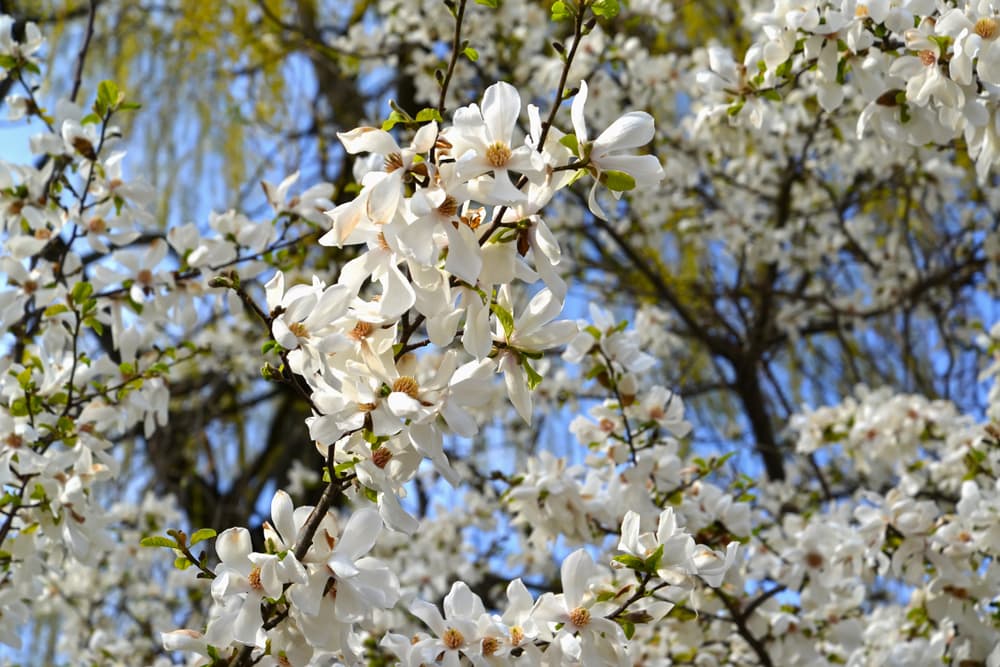
M. liliiflora

M. x loebneri
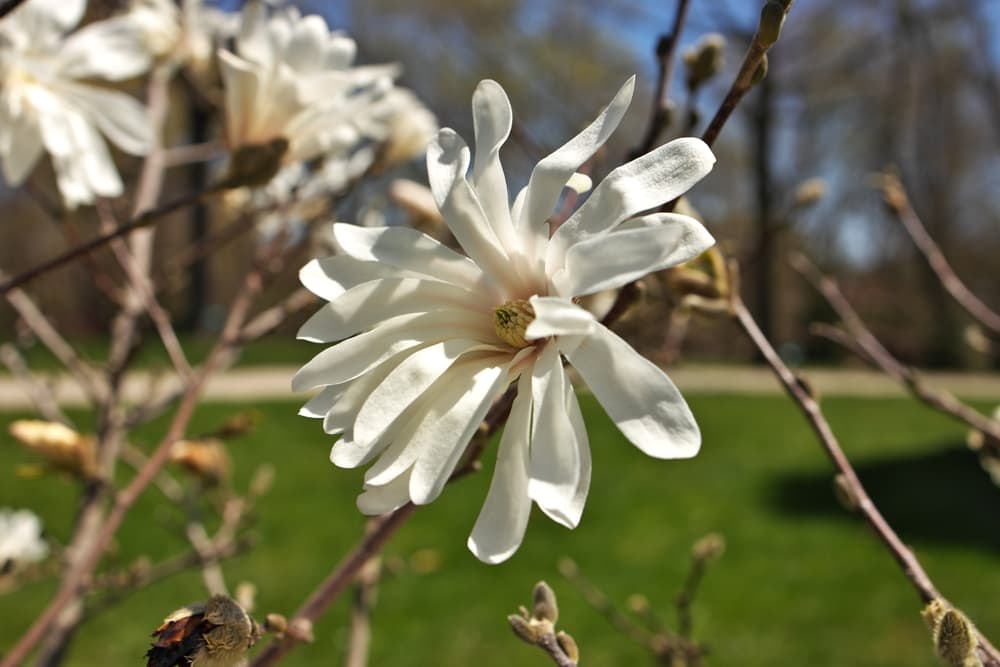
M. salicifolia
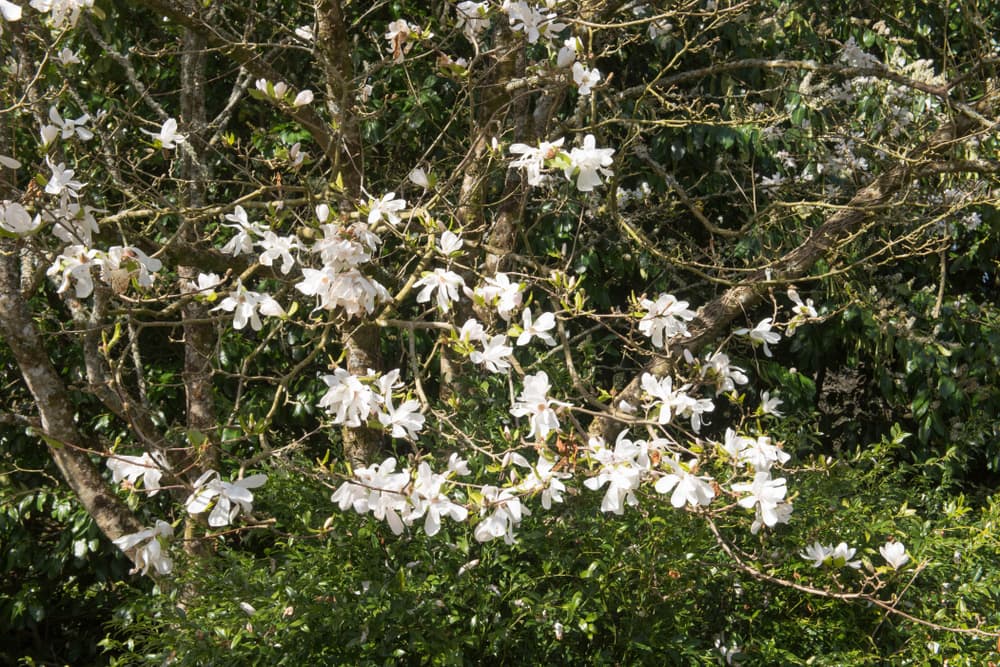
M. stellata
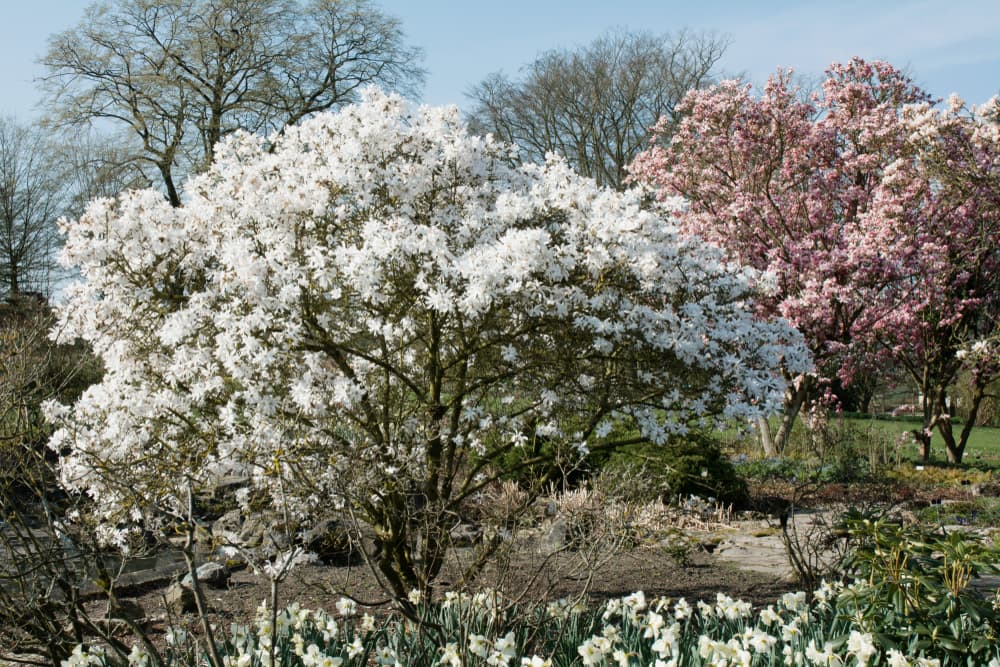
M. virginiana
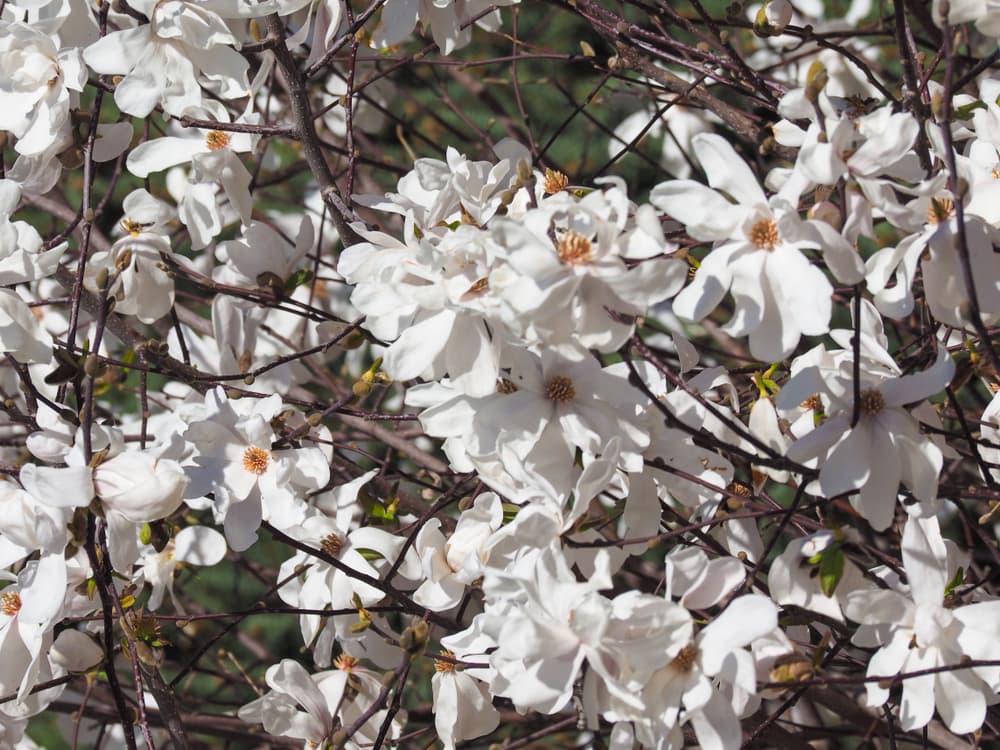
M. wilsonii
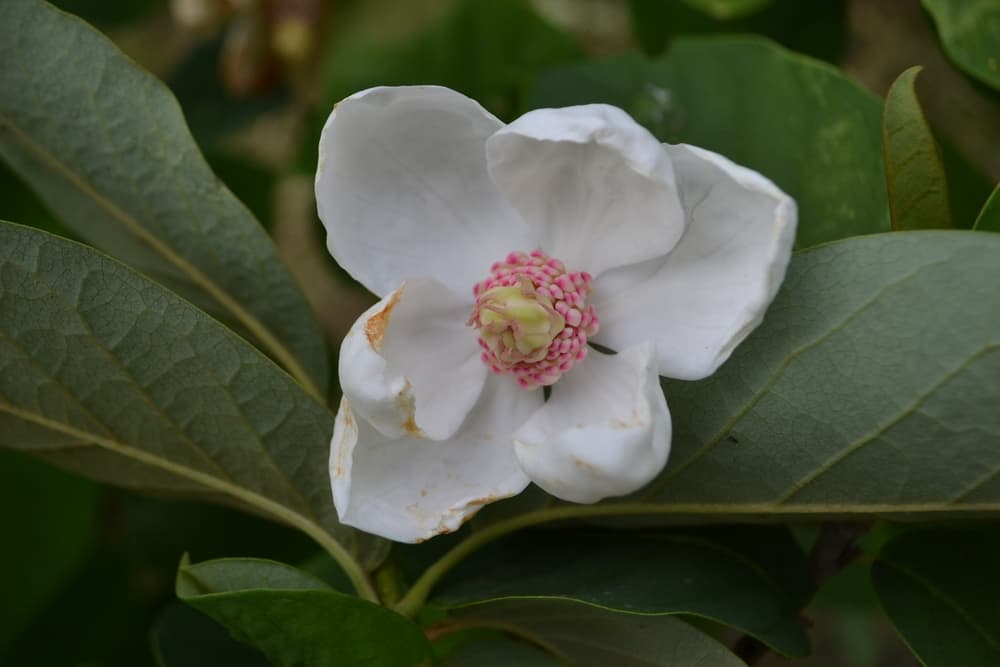
Magnolias can vary quite significantly from one another – some are deciduous and some are evergreen, and each one has a distinct flower shape, colour and form.
“For inspiration on which variety to choose I highly recommend a visit to Borde Hill Garden in West Sussex,” recommends Dan Ori, a Master Horticulturist.
“You will experience a fantastic collection of Magnolias from March to May, with most plants handily labelled.”
How To Grow A Magnolia Tree
Most magnolia trees must be grown in full sun, in a warm and sheltered position.
They are typically H6 hardy, but their flowers can easily be damaged by frost in the spring and frost can also damage evergreen foliage in autumn.
Exposure
A sheltered site is particularly important – M. grandiflora and M. delavayi will thrive when espaliered against a warm south-facing wall, and may not survive the winter outdoors in areas where winter temperatures drop below roughly -5°C.
Wind damage can be a problem, so magnolias must be planted where wind rock and wind damage to leaves will not be a problem.
Soil Requirements
Most magnolia trees will do best in an acidic or neutral soil – however, many Magnolia species can tolerate alkaline conditions.
In dry alkaline conditions, M. grandiflora or M. delayvayi could be good options to consider.

On moister soils, M. kobus, M. x loebneri or M. wilsonii could be good bets. M. grandiflora and M. virginiana will tolerate wetter soil conditions.
However, if you do have alkaline soil, particularly very alkaline soil, you will usually do better to grow a smaller magnolia specimen in a container, with a moderately acidic potting mix.
“I have had success on moist but not waterlogged alkaline soil with Magnolia stellata,” adds Dan.
“This spring star with showy fragrant flowers often blooms before leaves emerge giving you a magnificent constellation of white blooms enhanced by a background of dark stems.”
Sunlight
If you do not have an area with full sun and would like to grow a magnolia in light, dappled shade, then late-flowering species like M. sieboldii and M. wilsonii can tolerate this best.
However, you should always grow magnolias in full sun here in the UK where possible.

These later flowering species can also be the best bet in cooler, more northerly regions.
Planting
Magnolias are usually best planted in the autumn, or in the late spring.
Since these trees have rather shallow roots, you do not need to dig a very deep hole so planting is relatively easy.
Make sure that you dig your planting hole to the same depth as the pot the magnolia came in, and make sure that the point where it has been grafted is not below the soil.

Avoid doing any damage to the roots of the plant, since any damage to the roots can affect flowering.
Firm the soil back gently around the tree, tamp it down, and water well.
It is a good idea to mulch around your new magnolia tree with an organic mulch of bark, leaf mould or garden compost.
Magnolia Tree Care
To promote good growth and healthy flowering, make sure a magnolia gets as much sun as possible.
However, it is also important to ensure that the soil in the planting location does not dry out during the summer months.

Always take care to water in dry weather, especially before the tree reaches maturity.
Remember, watering needs will be higher when a magnolia is grown in a container.
Pruning Guidelines
Once your magnolia tree has flowered (which, depending on variety, will be sometime between March and August), this is a good time to undertake any necessary pruning.
Magnolias should only be pruned lightly, to remove any dead, damaged, diseased branches, or any branches which cross and are rubbing against one another.
These trees do not respond well to more extreme pruning, and can stop flowering when pruned too zealously.
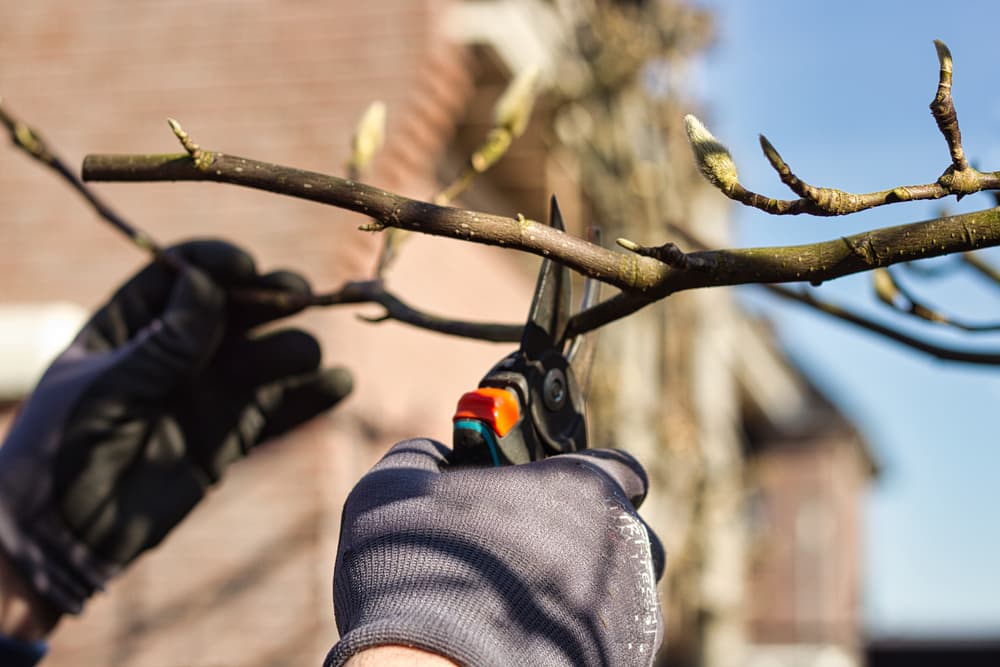
If you have a mature magnolia tree that requires renovation, it is best to undertake this work gradually over a number of years – pruning only a few branches at a time so as to reduce stress.
Each spring, you should replenish the mulch around your magnolias, to maintain fertility.
Use composted wood chip or bark, leaf mould, compost, or a well-rotted manure.
Propagation
Should you wish to propagate new plants from a Magnolia tree, this can be done by taking cuttings.
It is best to take softwood cuttings from deciduous magnolias in early summer, and semi-ripe cuttings from evergreen types in late summer or early autumn.
However, note that this is not the easiest garden task for beginners, and cuttings may need extra light and heat in winter.
Lack Of Flowering
The most common issue encountered by those trying to grow Magnolia trees is a lack of flowering.
It is most important to make sure that you have planted your Magnolia tree in an appropriate position, and chosen the right species for your situation.

It is also important to note, however, that newly planted trees might not flower at first.
It can take a few years for a newly planted Magnolia tree to ‘settle in’ before it flowers.
References
- 1Magnolia Pollination. (2018, May 5). Illinois Extension. Retrieved March 21, 2023, from https://extension.illinois.edu/blogs/garden-scoop/2018-05-05-magnolia-pollination
- 2Magnolia. (n.d.). Kew Royal Botanic Gardens. Retrieved March 21, 2023, from https://powo.science.kew.org/taxon/urn:lsid:ipni.org:names:30000709-2
- 3Matilda, A. (2022, August 20). Pickled magnolias: spring’s first flowers are edible, with a potent spicy kick. The Guardian. Retrieved March 21, 2023, from https://www.theguardian.com/food/2022/aug/21/pickled-magnolias-springs-first-flowers-are-edible-with-a-potent-spicy-kick
